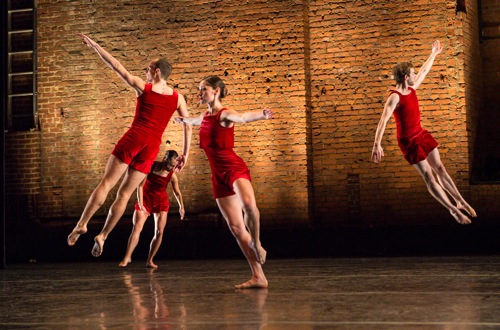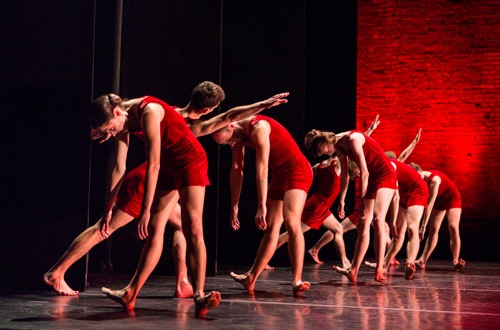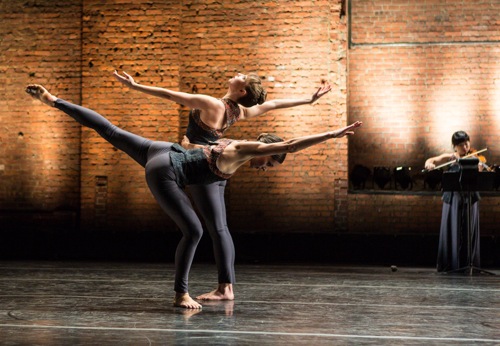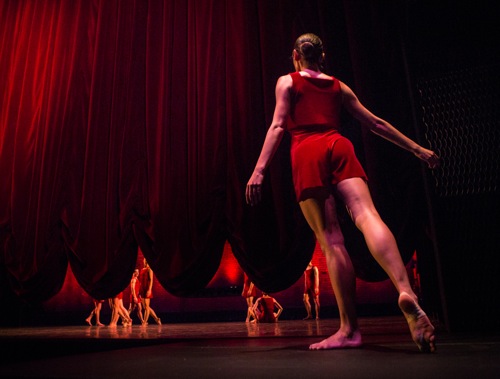Pam Tanowitz makes her Joyce debut February 4-5 with two premieres.
If Pam Tanowitz had been baptized into dance as an infant, Merce Cunningham and George Balanchine would surely have been standing on either side of the font, ready to serve as godfathers. Tanowitz’s choreographic works, like those shown on her recent program at the Joyce Theater, tell no stories. Nor do they seethe with emotion. The dancers do not fling themselves about, letting an impulse trail off or ignite some new loose-edged maneuver. “Rebound” is a minor word in their movement vocabulary.
Instead, they stand tall; flash long, straight legs; stride out, often on tiptoe; and bound into the air They keep their feet busy printing out rhythms. Their arms carve and slice the space with precision. They bend and angle their bodies. If this sounds dry, it isn’t really; within the territory Tanowitz has mapped out for herself, vivid images and surprises crop up in the elegant structures. She is a very accomplished choreographer, shaping movement for contrasts in scale, speed, and spatial design that never appear arbitrary or tricky.
The opening work on the program is an introduction to her style. It’s a new duet, Passagen, for Maggie Cloud and Melissa Toogood, set to a composition of the same name by John Zorn. Three music stands are stationed in different places on the stage but out of the way; guest artist Pauline Kim Harris, moves among them to play Zorn’s tempestuously virtuosic solo for violin. Reid Bartelme has costumed Harris in a long, dark gray skirt and a vest that relates to the short, halter-topped tunics that Cloud and Toogood wear above their gray tights.
Against the Joyce’s brick rear wall, which responds warmly to Davison Scandrett’s lighting, the two expert women engage in individual patterns that may turn out to be the same pattern slid into canon. When Cloud and Toogood advance in unison, they make me think of well-disciplined cadets embarking on an unusually attractive march. You could attach ballet terms to many of their movements, but they don’t really look balletic in this context. And during a passage when the two touch each other, their moments of contact are understated—a bracing hand here, a grip that’s not a grip. It’s during Passagen that I become aware of how adept Tanowitz is at making dancing look fully three-dimensional—turning and angling the movements so that you see the performers as the multi-faceted people that they are, and the space as full of possibilities.
The Joyce program lasts less than an hour, so no intermission. Instead, Tanowitz fills the necessary pause between Passagen and the other premiere, Heaven on One’s Head, with Pause Dance. The red front curtain is raised a little above the floor and Sarah Haarmann appears on a small, specially rigged platform in front of it stage left, studiously moving her limbs within the confined space, while Dylan Crossman (like Toogood, a onetime dancer with Cunningham’s company) watches her. Behind her, the stage gradually fills with dancers, and the curtain lifts a little further. As Crossman takes Haarmann’s place on the platform and inherits her movements, the members of the FLUX Quartet come down an aisle to take their places in a corner of the house.

(L to R): Max King, Vincent McCloskey, Melissa Toogood, and Andrew Champlin in Tanowitz’s Heaven On One’s Head. Photo: Yi-Chun Wu. Photo: Yi-Chun Wu
The transition concludes smoothly. The dancers begin to dance; others arrive and wait to join. The musicians (Tom Chui, violin; Conrad Harris, violin; Max Mandel, viola; and Felix Fan, cello) start to play Conlon Nancarrow’s String Quartet No. 1, the curtain continues its ascent, and here we are in Heaven on One’s Head. Tanowitz doesn’t follow the music (Nancarrow’s String Quartet No. 3 is also played) note for note, or even phrase for phrase, but the choreography alludes to its changes of quality and mood—now a sprightly, melodic 6/8 rhythm, now a slow, spare passage, now a jolt of pizzicato playing, now turbulence, etc.
In this dance for eight, Tanowitz plays around with symmetry and how it may be tugged into something else. The dancers are almost identically clad in trim, red velour outfits: shorts and sleeveless tops (the women’s are bolero-length). You might see the cast as an apolitical red army, with individuals coming and going at will, sometimes hanging out near the wings and watching. Once a dancer (Crossman as I remember), falls halfway in from offstage, retreats, does it again, retreats. . . .
Tanowitz pairs her dancers into male-female couples, with each pair doing something different. She lines everyone up vertically close to the wings or in the middle of the space, as if they might be considering a Virginia Reel. The four women (Cloud, Toogood, Haarmann, and Lindsey Jones) rip into a display of watch-my-feet! speed. At times, the men too assemble: Crossman, Andrew Champlin, Jason Collins, Vincent McCloskey, and Max King. But this is an egalitarian society. Everyone’s a jumper and a zesty one. Everyone gets a moment or two to stand out.
In the middle of Heaven on One’s Head, Tanowitz provides an interlude that echoes Pause Dance. The curtain starts to lower, and Toogood moves onto the little platform. While a few high notes sound, she watches the others’ feet walk onto the stage and start jumping—assemblés, chassés, you name it. Then they lie supine. Toogood twitches her arms around and kneels. The curtain goes up again on a red-lit stage. (Could this episode be a reference to Toogood’s role as rehearsal director?)
In one of Tanowitz’s most fascinating passages, each pair of dancers has its own phrase of movement, but every individual has his or her own spatial pattern and facing. And they’re separated, so that, for instance, one member of a couple may be downstage left facing upstage, while the partner is located upstage right facing downstage. The resulting image is a wonderfully complex one—both symmetrical and askew, orderly yet buzzing with activity, always shifting within the framework of the stage.
Tanowitz doesn’t give Heaven on One’s Head a big, conclusive ending. The last thing you see is Crossman taking off in a big, almost unruly pas de chat into the wings, just as the curtain finally makes up its mind to come down.




Christopher Pilafian sent this comment via e-mail:
Deborah,
As always, a pleasure to read your lucid and layered descriptions of events. I have forwarded this to all our dance majors. I would like them to start reading you, if they have not already done so.
Best wishes and thank you for continuing to enrich and validate this form we love so much.
Christopher